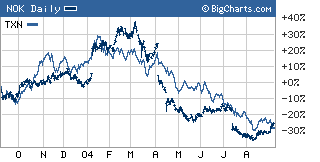
NEW YORK (CNN/Money) -
How do you say Lazarus in Finnish?
About two months ago, I wondered how to say "unmitigated disaster" in that Nordic tongue after Helsinki-based Nokia issued yet another profit warning.
But on Thursday, Nokia looked to have sprung back to life, lifting sales and earnings targets. The leading maker of cell phones cited particularly strong demand.
This follows a more bullish than expected mid-quarter update on Wednesday from Texas Instruments, the largest maker of semiconductors used in cell phones. Nokia is TI's largest customer.
During a conference call, a TI exec went out of his way to stress that the wireless business wasn't nearly as moribund as many were making it out to be.
Shares of both Nokia (NOK: Research, Estimates) and TI (TXN: Research, Estimates) soared more than 6 percent Thursday.
And the double dose of good news had a profoundly positive impact on other stocks with exposure to cell phones.
Nokia rival Motorola (MOT: Research, Estimates) enjoyed a nice pop.
And so did shares of cell phone chip companies RF Micro Devices (RFMD: Research, Estimates), Skyworks Solutions (SWKS: Research, Estimates), TriQuint Semiconductor (TQNT: Research, Estimates) (which actually lowered its sales guidance Tuesday), and OmniVision Technologies (OVTI: Research, Estimates).
Making a comeback
So is Nokia really back on track?
Since Nokia did lift its earnings target for the quarter by about 33 percent, it appears fears that Nokia would drastically slash prices on older, cheaper phones -- which could have dampened its profits -- were for naught.
 |
|
| Have shares of Nokia and Texas Instruments finally bottomed? |
Casey Ryan, an analyst with Wells Fargo, said it looks like Nokia has been cutting prices on more expensive models, a move that appears to have worked in the company's favor, since it has spurred demand for more profitable phones.
"One of the market's assumptions was that Nokia would cut aggressively on the low-end, but by cutting prices only on the high-end segment, you can raise profit margins if you gain enough sales," said Ryan. "What is happening is a changing product mix."
In addition, Nokia indicated that it had shipped a large amount of new models to cell phone carriers and retailers in anticipation of the holiday shopping season.
One of the biggest problems facing Nokia earlier this year was that it was late in getting so-called clamshell models (phones that flip open) to the market. Rivals capitalized on this.
| Recently in Tech Biz
|

|
|
|
|
Thomas Carpenter, an analyst with Hilliard Lyons, cautiously points out that there is a difference between shipping a phone and actually selling it. Still, he's confident that the new models will be hot sellers during the fourth quarter, particularly in the North American market, where Nokia has really lost ground to companies like Motorola, Samsung and LG.
"This is a step in the right direction since the product lineup was getting stale," Carpenter said. "This doesn't mean that Nokia has solved all its problems but it does have more competitive products coming out toward the end of the year."
Good news for wireless...but the rest of tech?
Now what does this say about overall cell phone demand? Worries about a major slowdown seem to have been overblown after all. Inventory concerns could in fact be temporary.
TI said on Thursday that it was really only seeing a major handset inventory problem in China. And Nokia said that sales of cell phones were particularly strong in Europe, the Middle East and Africa.
The latest outlooks from Nokia and TI clearly illustrate the danger of lumping tech into one convenient category, a mistake often made by the market. It now appears that companies like TI were unfairly punished after Intel lowered its sales target last week.
But by the same token, the good news from Nokia and TI shouldn't be pointed to as evidence that all of tech is due for a rebound after a brutal summer.
All that Nokia and TI proved on Thursday is that retail sales of cell phones should remain healthy. This does not say anything about the state of corporate demand for things like servers and software or consumers' appetite for PCs.
Analysts quoted in this story do not own shares of the companies mentioned and their firms have no investment banking relationships to the companies.
Sign up to receive the Tech Investor column by e-mail.
Plus, see more tech commentary and get the latest tech news.

|

